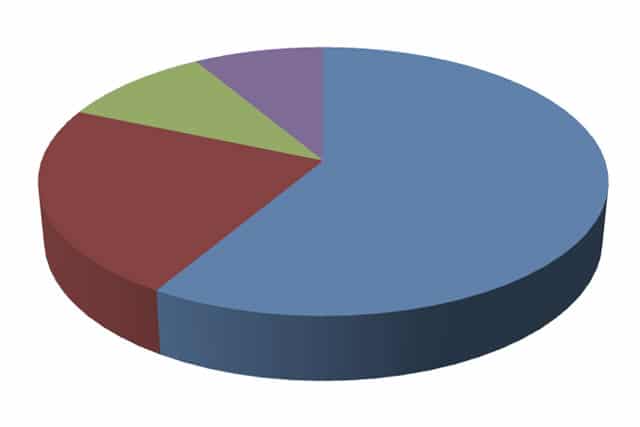By Michael Seid, Managing Director, MSA Worldwide
Avoid setting franchise fees too low or too high
Having adequate revenue to establish a sustainable, growing and financially viable franchise system is a franchisor’s principal long-term objective.
In Threshold Analysis Part Three, we addressed the different classes of franchisees, and how to determine which class or classes you should be focusing on as you conduct your threshold analysis. Here in Part Four, we’ll cover the support system and fees to consider for your franchise system during the Threshold Analysis.
A common error that inexperienced franchisors make when marketing their franchises is to tie the initial and continuing fees with the support services provided to franchisees. This eventually can lead to serious disruptions in the franchise relationships. As franchisees and their businesses mature in a system, they tend to need fewer services, want fewer restrictions on their operations, and often want lower fees.
Well-drafted franchise agreements strive to decouple initial and continuing fees from the services provided to franchisees, and define the fees paid by franchisees as compensation for their use of the franchisor’s intellectual property and not for any specific service provided. In a practical sense, the support and other continuing services provided by franchisors are mainly to protect the franchisor’s intellectual property by ensuring that franchisees have the tools necessary to consistently deliver the system’s brand promise to consumers.
Even though there should be a decoupling of services to fees in the franchise agreement, services provided by the franchise system to franchisees will still require the franchisor to make expenditures. It is essential in evaluating franchise ability to determine whether there will be an adequate revenue stream to cover the franchisor’s costs and allow the system to be sustainable.
During the Threshold Analysis, you need to evaluate and measure your:
- Realistic system growth projections
- Geographical approach to expansion
- Cost of acquiring each class of franchise, including any commissions paid to your internal development staff or outside brokers or other third parties
- Cost of providing initial and continuing headquarters and field support services
- Sources of additional and sustainable revenue for the franchisor and its affiliates
First, though, you need to carefully evaluate the unit economics for your intended franchise system. It is relatively easy to project single-unit economics, assuming you have your own history of operations upon which to base your projections, and that your franchise expansion strategy is targeted to markets in which your brand is already known. If you have recently opened company-owned locations, the timing and cost of unit development, subject to your target market selection, should make it relatively easy to project the initial investment required for a single location.
Developing economic models
Based on the information developed for the proposed franchisor and the unit franchisee, economic models should be developed to determine the financial viability of the franchise system. Determining the system’s economic viability at the unit franchisee level will rest on your ability to impose fees that enable both the franchisee and franchisor to achieve your predetermined targeted rate of return on their investment.
Setting the types and ranges of fees are some of the most difficult determinations an emerging franchisor will need to make, and these determinations should be carefully crafted during the development of the terms of the franchise offering. Included in Threshold Analysis should also be whether other sources of revenue, including supply chain income, will be available and sustainable.
One of the major problems for emerging franchisors is setting fees too low or too high.
- If franchise fees are set too high, the franchise offering may not be marketable against the competition and even if it is, the franchisees may not have sufficient bottom line revenue to be sustainable.
- If franchise fees are set too low or the additional sources of continuing revenue are overestimated or prove not to be sustainable, the franchisor’s revenue may not be sufficient to provide the promised services to franchisees or meet the franchisor’s financial hurdles. Neither is an acceptable alternative.
Often, new franchisors set their fees based primarily on those charged by their direct “retail” level competitors. This is a common technique used by many new franchisors and also a common shortcut used by franchise-packaging firms, brokers, and lawyers that provide franchise advisory services to emerging franchisors; it can, unfortunately, lead to long-term financial and relationship issues. Simply having lower fees is not necessarily a competitive determinant.
Franchise systems compete on at least two levels:
- Their company-owned and franchised locations compete at the local level for the end user customer, but as franchisors,
- They compete with other franchisors and non-franchised investments for potential franchisees.
When MSA Worldwide works with established franchisors, in understanding the root causes for some of their issues, invariably we encounter that their fees were originally determined by doing little more than mirroring the fees of direct retail competitors. Once established, franchise fees become relatively fixed, especially during the term of the franchises that have agreements. While there certainly can be changes prospectively, and frequently are, the ability of the franchisor to modify its fees long-term will be impacted to some degree by their starting point.
Model fees on your unique franchise system
One reason that using retail-level competition as the primary basis for setting fees is problematic is that each franchise system differs in many ways, including but not limited to their costs of recruiting and supporting franchisees. Consider McDonald’s, Burger King, Wendy’s, and include Five Guys and Smashburger – each a franchisor with a primary core offering including hamburgers. Even a surface examination of each franchise system at the franchisor level will reveal material differences, including:
- Maturity
- System size
- Brand identification
- Profile of franchise
- Methods and costs in recruiting franchisees
- Real estate strategy including critical mass, territorial rights, and encroachment policy
- Training requirements, methods, and costs
- Growth strategy
- Classes of existing franchisees
- Services provided to franchisees
- Span of control and cost of providing services to franchisees
- Additional sources of sustainable revenue, in addition to fees (a la carte fees, real estate, supply chain, etc.)
- Term of offering
- Successor terms
- Reinvestment requirements; and
- A host of other critical variables based on the structure of each franchise organization
For these reasons, initial and continuing fees should always be modeled first based primarily on the business and financial requirements of the franchise system, and then fine-tuned based on competition and further on the positioning of the brand.
Sophisticated franchisees generally choose franchisors based first on industry clusters that interest them (i.e., personal service offerings like massage, fitness, hair care and tanning, or restaurant offerings like hamburgers, deli, pizza, Mexican, etc.). Then they begin weeding through opportunities in those industry clusters. You need to first understand the profile of your targeted franchisee, and then gain an understanding of your true franchise competitor, both within and outside of your direct retail competitors.
Franchise systems that offer similar or identical products or services at the retail level are different, and these differences can be material. Consider the variations between competing for retail-level franchise systems in any industry. These can include:
- Geography
- Market critical mass
- Types and cost of retail locations
- Types and cost of service delivery
- Variations in brand popularity
- Franchise investment
- Unit sales
- Cost of goods
- Cost of labor
- Supply chain
- Local cost of operations
- Pricing strategy
- Product and service innovation
- Retail marketing
- Services provided by franchisor
- Term of offering
- Successor terms
- Reinvestment requirements; and
- A host of other critical variables
Whether the franchisor and franchisee are projected income and return on investment are sufficient will be one of the major determinants you will be considering. To accomplish that assessment, detailed economic modeling needs to be prepared for the franchisor and each class of franchise as part of the Threshold Analysis.
Craft your fees by class of franchisee
Still further, each class of franchise make their investment decision differently. While still an emerging trend, we are well past the time when the initial or continuing fees or the terms of the franchise offering should be the same for each class of franchise. In crafting your fees by class of franchisee, you have the opportunity to design the franchise system in a way that varies the obligations of both the franchisee and franchisor, and by doing so maximize the attractiveness of the franchise opportunity and which benefits the relationship between the franchisor and franchisee.
Keep in mind that you are not determining a final fee structure during the Threshold Analysis. Instead, you are assessing whether potential revenue and costs will allow you to meet the financial expectations of the franchise system and each class of future franchise. Determining the final fee structure will come during the franchise system design phase, when each of the variables is examined in detail and the costs are better known.
During the Threshold Analysis, you need to develop initial economic models for each class of franchise and the franchise system as a whole, including the franchisor’s affiliates. It is not important at this juncture to settle on final fees or how those fees will be structured. The goal is to determine if the available range of fees and other sources of sustainable income will be sufficient for the franchisor and affordable of each class of franchise. Determining early in the franchise development process which classes of franchisees you should be targeting will enable you later to target the development of your franchise system.
In Threshold Analysis Part Five, we’ll cover how to analyze your ability to expand your franchise system, including market development strategy and comparing indirect and direct methods of franchise marketing.
Do you have questions about franchising your business?
MSA Worldwide provides expert guidance on building a successful and sustainable franchise business. Contact us today for a complimentary consultation.




